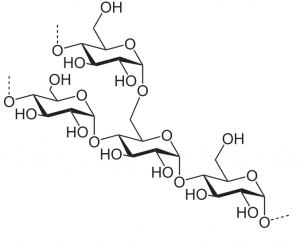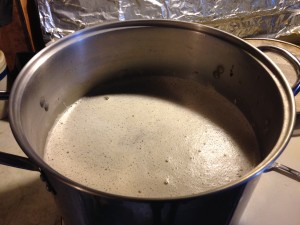This is the fifth article in this series on starch. After an introductory article, I have posted articles on amylose, amylopectin, and starch granules.
In the mash, brewers need to get the starch-degrading enzymes (amylase enzymes) to reduce the large molecules of amylose and amylopectin into mixture of fermentable carbohydrates (esp. the sugar maltose) and non-fermentable carbohydrates. In order for this to occur, the starch needs to be dissolved in water hot enough to dissolve it. This step is call gelatinization, even though gelation might be a more appropriate term. (When starch is dissolved in water, it would be more appropriate to describe the result as a gel. Gelatin is an animal product, formed from collagen.) However, the term “gelatinization” is firmly entrenched in the brewing literature, so I’ll use it here.
Gelatinization Temperatures
Barley starch is a mixture of amylose and amylopectin. The percentage of each component can vary and the length of amylose helices and the size of amylopectin molecules can also vary between different varieties of barley. And, as we’ve seen, starch is packaged into granules, and is associated with varying levels of proteins and lipids. As such, there is no one temperature that could be given as the gelatinization temperature for barley starch. Barley starch from malted barley typically gelatinizes in the 138–145 °F (59–63 °C) range, but various studies have documented temperatures from 126–154 °F (52–68 °C).
The Process of Gelatinization

The hydroxyl groups (—OH) hanging off the amylopectin molecule associate with water as the starch is being hydrated and dissolving.
When starch granules are exposed to hot water, the amorphous regions (composed of mostly amylopectin) begin to swell first. As the starch molecules begin to dissolve and are “opened up,” water molecules progressively become associated with the hydroxyl groups (—OH) on the outside of the molecule. This swelling disrupts the layered structure of the granules.
Smaller granules — which typically have higher amylose levels and more protein on their exterior — gelatinize at slightly higher temperatures than the more amylopectin-rich large granules. (And remember, most of the weight of the starch comes from large granules.)
Older studies have shown different patterns of gelatinization (with regards to how quickly large and small granules dissolve) in different barley varieties.
Gelatinization Temperature Can Change
A final interesting fact is that the gelatinization temperature of a given starch can change. If you could go into a hunk of starch and align a higher percentage of the amylose molecules so that they formed a larger crystalline region, rather than being more interspersed with amylopectin molecules, you could raise the gelatinization temperature of that mass of starch. And, as it turns out, you can do that.
If you were to add the minimum amount of water to hydrate a bit of starch, and hold it just below the gelatinization temperature, the starch would slowly rearrange itself, with more amylose helices lying in parallel to each other, forming a more compact, crystalline region within the starch. If you were then to let this starch mixture cool, the gel would expel some of the water entrained in it and require a higher temperature to gelatinize the next time. This is called the retrogradation of starch. Under brewery conditions, it’s not likely to occur, but it’s an interesting phenomena. (You can actually heat potatoes, then cool them overnight to squeeze some of the water from them.)
Brewing Relevance
If most barley starch gelatinizes in the 138–145 °F (59–63 °C) range, then the usual range for a single infusion mash 148–162 °F (64–72 °F) should work fine. Obviously, this was something that brewers originally figured out by trial and error.
If you’re looking to brew a dry beer, an initial rest in the 140–145 °F (60–63 °C) will help, but the starch may not be fully gelatinized at that temperature, so a “finishing” rest in the 148–152 °F (64–57 °C) should be employed to finish the mash. (If you want to be doubly sure, employing a mash out — raising the grain bed temperature to around 168 °F (76 °C) — would also be a good idea.)
In the next article in this series, I’ll discuss the enzymes that are active in starch degradation and the factors that influence them.
—
Related articles


Interesting nugget indeed about the retrogradation of starch, especially potatoes. In order to make gnocchi, it is generally desirable to keep the potato starch as dry as possible, with some people going so far as to recommend letting the potatoes age for a while to expel water. It seems like the method of heating and cooling could greatly speed this process, and remove the risk of spoilage if the timing is off.
– Dennis, Life Fermented Blog
You could also try stirring in a small amount of potato flakes to absorb some of the moisture.